BULAW5914: Commercial Law Assignment - Negligence and ACL
VerifiedAdded on 2022/11/14
|12
|2991
|438
Case Study
AI Summary
This assignment is a commercial law case study analyzing a scenario involving a defective baby cot. It explores the legal principles of negligence, including duty of care, breach of duty, causation, foreseeability, and proximity. The case examines whether the parents, Priya and Rahul, can sue for injuries sustained due to the cot's collapse. The analysis delves into the Australian Consumer Law (ACL), specifically focusing on manufacturer liability for defective goods and consumer rights under sections 138-141. The assignment identifies the relevant parties, determines the basis for a claim under the ACL, and discusses the potential outcomes based on the provided facts, referencing key legal precedents and provisions within the ACL to support the arguments.
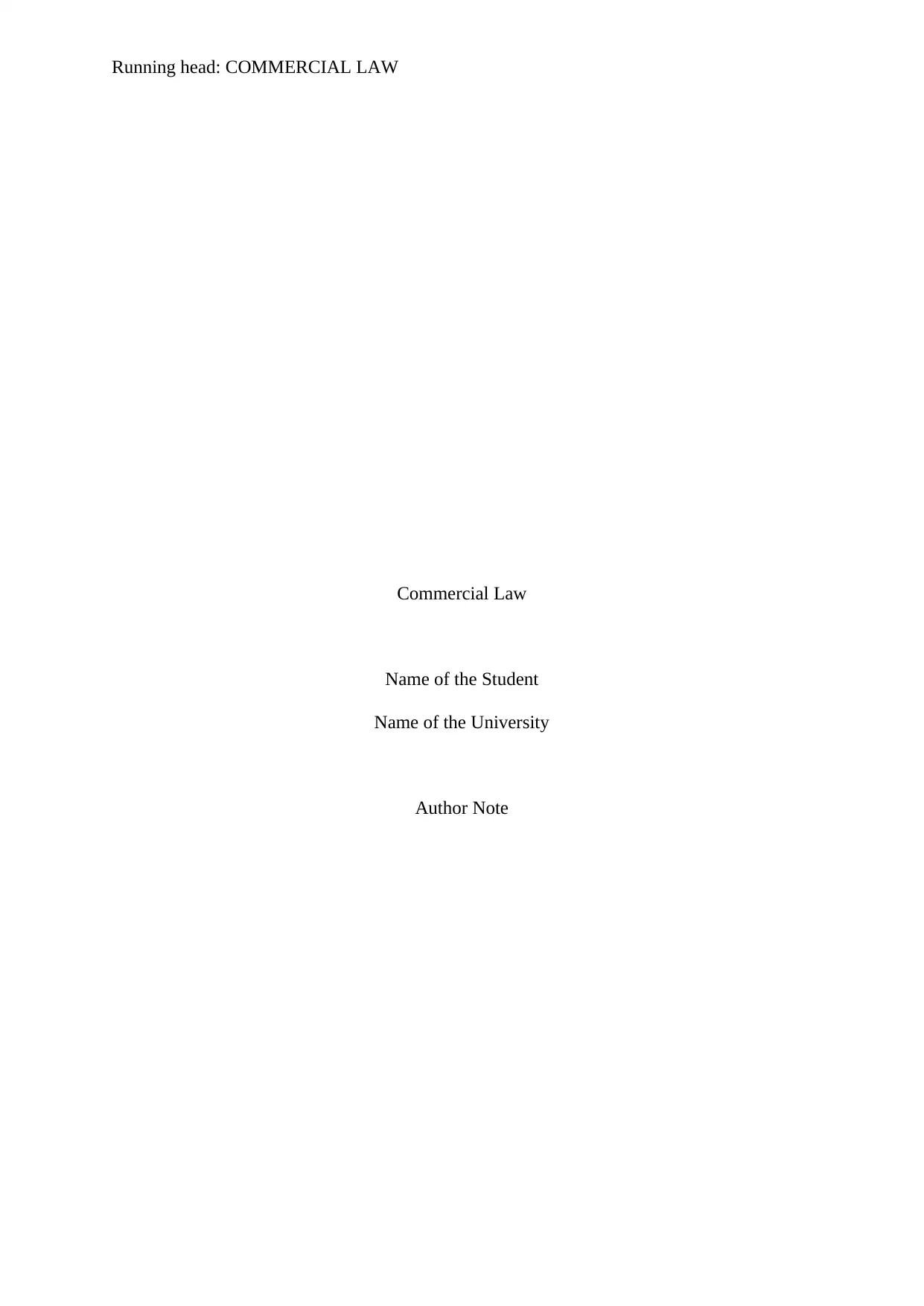
Running head: COMMERCIAL LAW
Commercial Law
Name of the Student
Name of the University
Author Note
Commercial Law
Name of the Student
Name of the University
Author Note
Paraphrase This Document
Need a fresh take? Get an instant paraphrase of this document with our AI Paraphraser
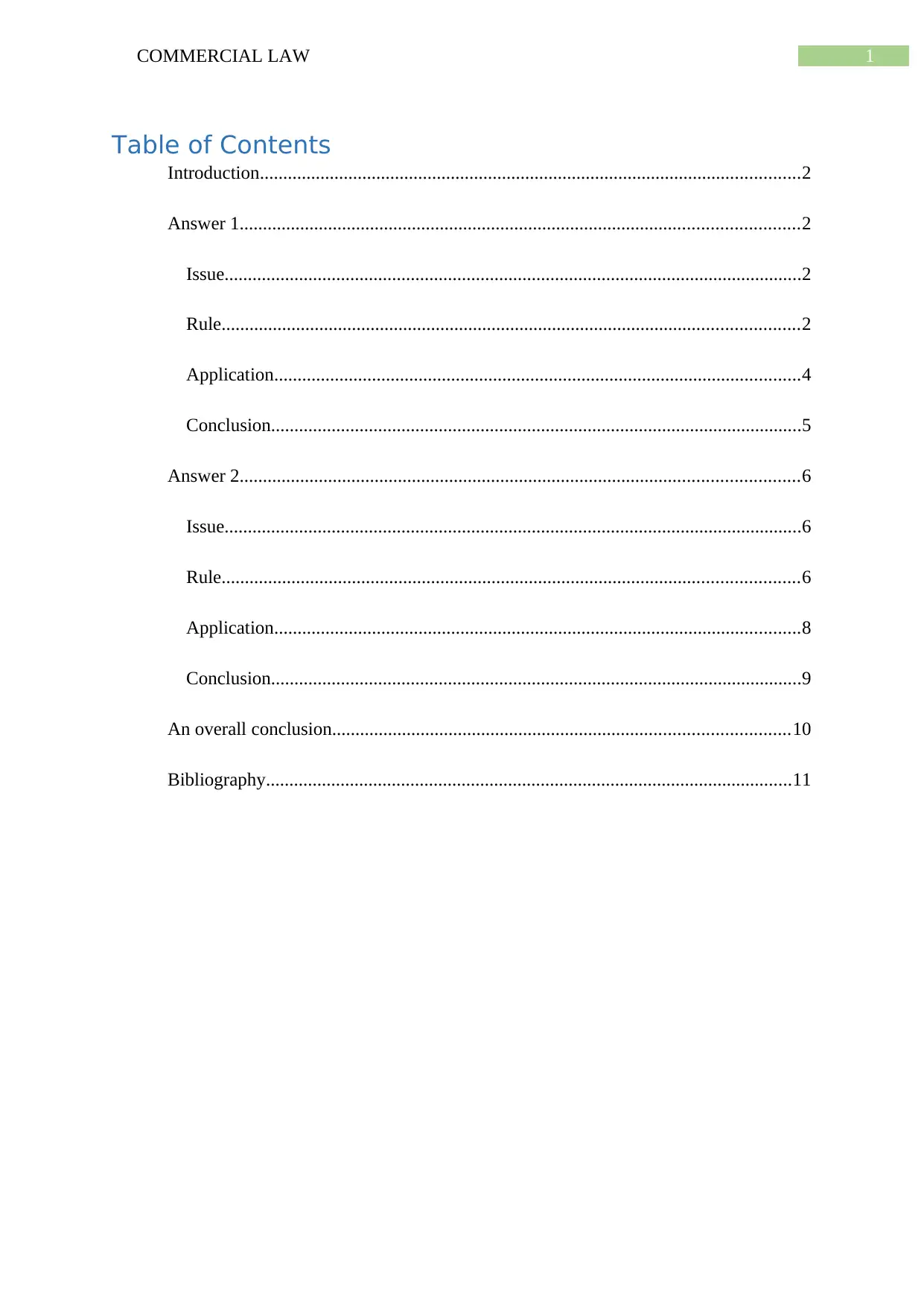
1COMMERCIAL LAW
Table of Contents
Introduction....................................................................................................................2
Answer 1........................................................................................................................2
Issue............................................................................................................................2
Rule............................................................................................................................2
Application.................................................................................................................4
Conclusion..................................................................................................................5
Answer 2........................................................................................................................6
Issue............................................................................................................................6
Rule............................................................................................................................6
Application.................................................................................................................8
Conclusion..................................................................................................................9
An overall conclusion..................................................................................................10
Bibliography.................................................................................................................11
Table of Contents
Introduction....................................................................................................................2
Answer 1........................................................................................................................2
Issue............................................................................................................................2
Rule............................................................................................................................2
Application.................................................................................................................4
Conclusion..................................................................................................................5
Answer 2........................................................................................................................6
Issue............................................................................................................................6
Rule............................................................................................................................6
Application.................................................................................................................8
Conclusion..................................................................................................................9
An overall conclusion..................................................................................................10
Bibliography.................................................................................................................11
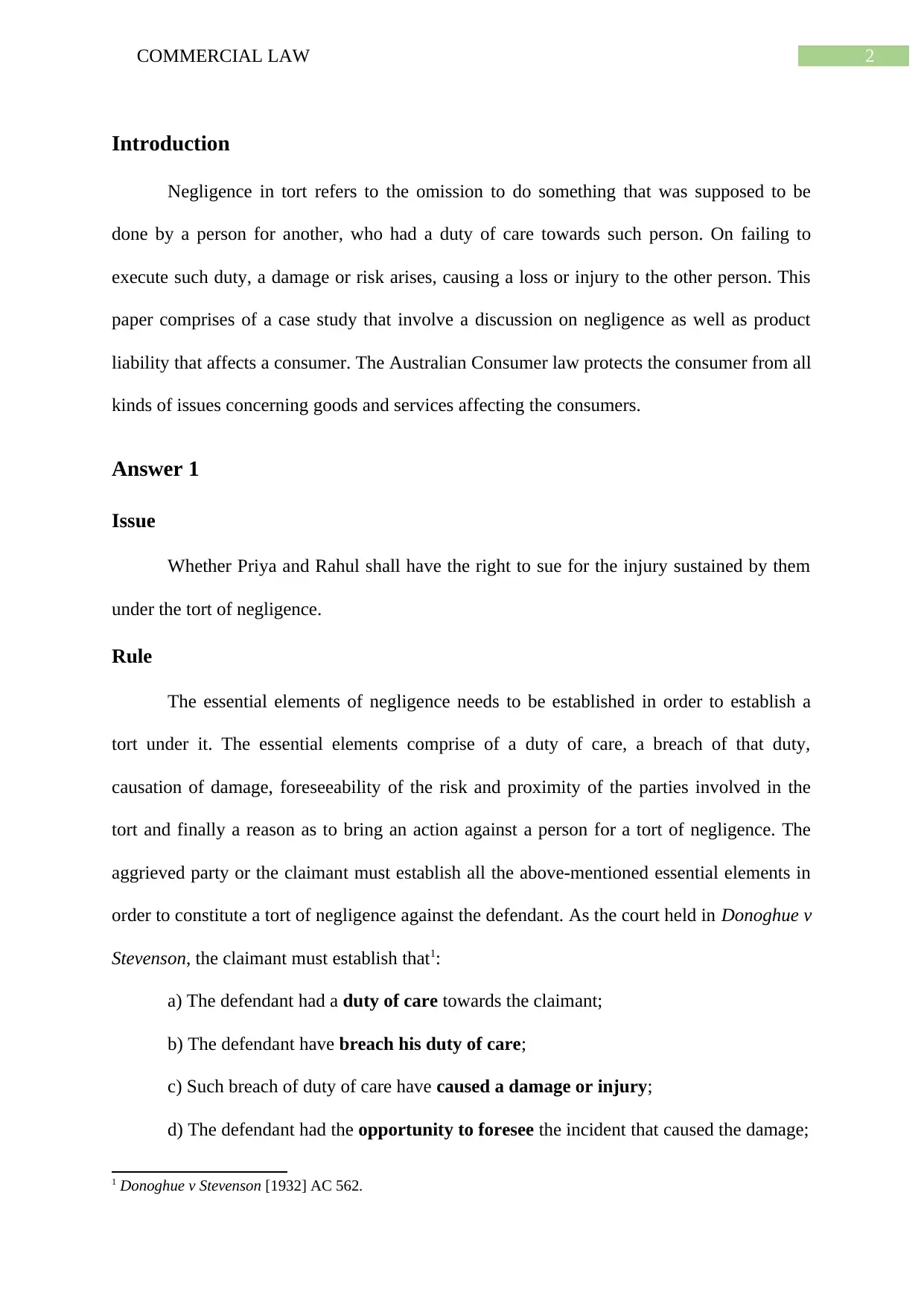
2COMMERCIAL LAW
Introduction
Negligence in tort refers to the omission to do something that was supposed to be
done by a person for another, who had a duty of care towards such person. On failing to
execute such duty, a damage or risk arises, causing a loss or injury to the other person. This
paper comprises of a case study that involve a discussion on negligence as well as product
liability that affects a consumer. The Australian Consumer law protects the consumer from all
kinds of issues concerning goods and services affecting the consumers.
Answer 1
Issue
Whether Priya and Rahul shall have the right to sue for the injury sustained by them
under the tort of negligence.
Rule
The essential elements of negligence needs to be established in order to establish a
tort under it. The essential elements comprise of a duty of care, a breach of that duty,
causation of damage, foreseeability of the risk and proximity of the parties involved in the
tort and finally a reason as to bring an action against a person for a tort of negligence. The
aggrieved party or the claimant must establish all the above-mentioned essential elements in
order to constitute a tort of negligence against the defendant. As the court held in Donoghue v
Stevenson, the claimant must establish that1:
a) The defendant had a duty of care towards the claimant;
b) The defendant have breach his duty of care;
c) Such breach of duty of care have caused a damage or injury;
d) The defendant had the opportunity to foresee the incident that caused the damage;
1 Donoghue v Stevenson [1932] AC 562.
Introduction
Negligence in tort refers to the omission to do something that was supposed to be
done by a person for another, who had a duty of care towards such person. On failing to
execute such duty, a damage or risk arises, causing a loss or injury to the other person. This
paper comprises of a case study that involve a discussion on negligence as well as product
liability that affects a consumer. The Australian Consumer law protects the consumer from all
kinds of issues concerning goods and services affecting the consumers.
Answer 1
Issue
Whether Priya and Rahul shall have the right to sue for the injury sustained by them
under the tort of negligence.
Rule
The essential elements of negligence needs to be established in order to establish a
tort under it. The essential elements comprise of a duty of care, a breach of that duty,
causation of damage, foreseeability of the risk and proximity of the parties involved in the
tort and finally a reason as to bring an action against a person for a tort of negligence. The
aggrieved party or the claimant must establish all the above-mentioned essential elements in
order to constitute a tort of negligence against the defendant. As the court held in Donoghue v
Stevenson, the claimant must establish that1:
a) The defendant had a duty of care towards the claimant;
b) The defendant have breach his duty of care;
c) Such breach of duty of care have caused a damage or injury;
d) The defendant had the opportunity to foresee the incident that caused the damage;
1 Donoghue v Stevenson [1932] AC 562.
⊘ This is a preview!⊘
Do you want full access?
Subscribe today to unlock all pages.

Trusted by 1+ million students worldwide
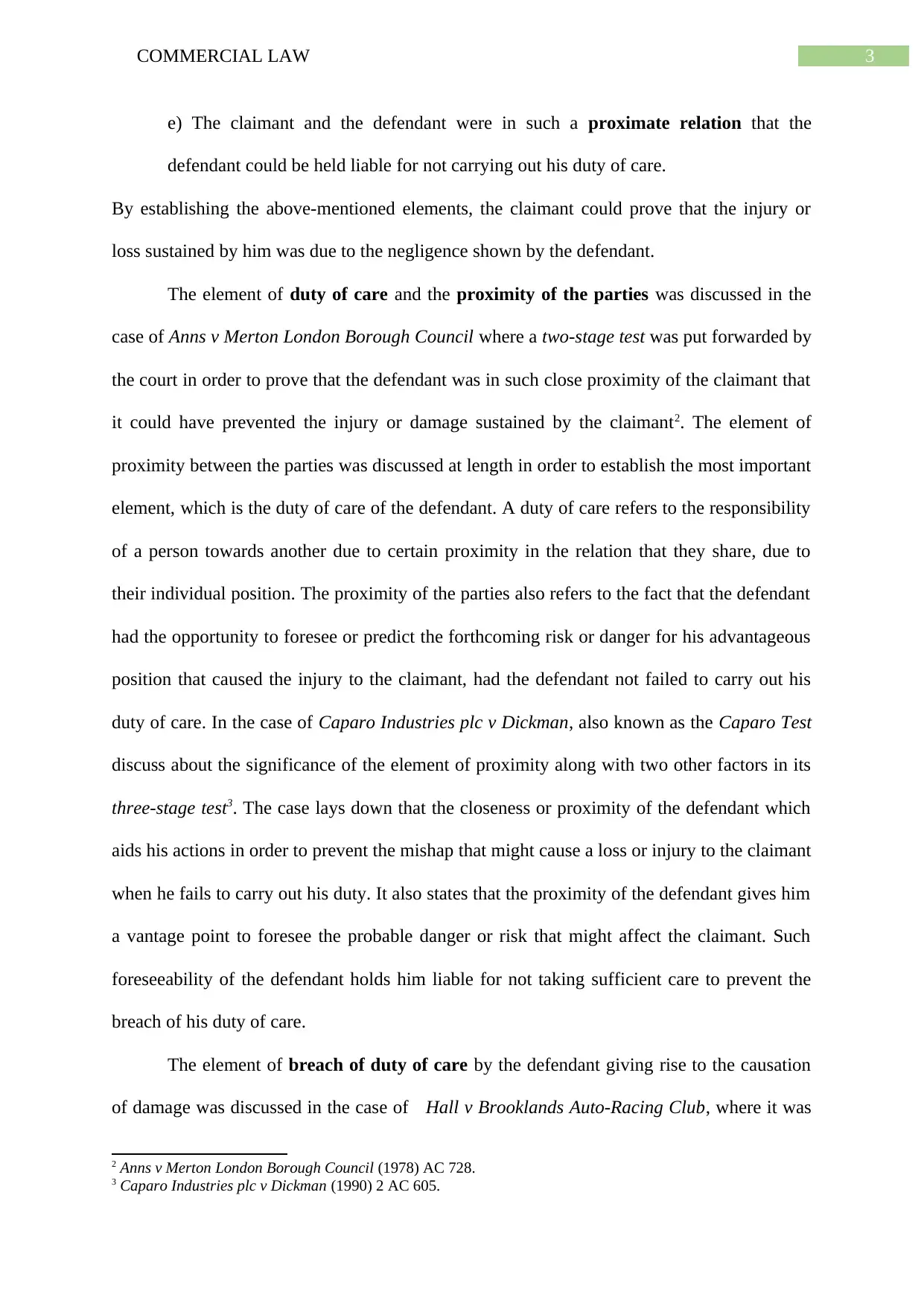
3COMMERCIAL LAW
e) The claimant and the defendant were in such a proximate relation that the
defendant could be held liable for not carrying out his duty of care.
By establishing the above-mentioned elements, the claimant could prove that the injury or
loss sustained by him was due to the negligence shown by the defendant.
The element of duty of care and the proximity of the parties was discussed in the
case of Anns v Merton London Borough Council where a two-stage test was put forwarded by
the court in order to prove that the defendant was in such close proximity of the claimant that
it could have prevented the injury or damage sustained by the claimant2. The element of
proximity between the parties was discussed at length in order to establish the most important
element, which is the duty of care of the defendant. A duty of care refers to the responsibility
of a person towards another due to certain proximity in the relation that they share, due to
their individual position. The proximity of the parties also refers to the fact that the defendant
had the opportunity to foresee or predict the forthcoming risk or danger for his advantageous
position that caused the injury to the claimant, had the defendant not failed to carry out his
duty of care. In the case of Caparo Industries plc v Dickman, also known as the Caparo Test
discuss about the significance of the element of proximity along with two other factors in its
three-stage test3. The case lays down that the closeness or proximity of the defendant which
aids his actions in order to prevent the mishap that might cause a loss or injury to the claimant
when he fails to carry out his duty. It also states that the proximity of the defendant gives him
a vantage point to foresee the probable danger or risk that might affect the claimant. Such
foreseeability of the defendant holds him liable for not taking sufficient care to prevent the
breach of his duty of care.
The element of breach of duty of care by the defendant giving rise to the causation
of damage was discussed in the case of Hall v Brooklands Auto-Racing Club, where it was
2 Anns v Merton London Borough Council (1978) AC 728.
3 Caparo Industries plc v Dickman (1990) 2 AC 605.
e) The claimant and the defendant were in such a proximate relation that the
defendant could be held liable for not carrying out his duty of care.
By establishing the above-mentioned elements, the claimant could prove that the injury or
loss sustained by him was due to the negligence shown by the defendant.
The element of duty of care and the proximity of the parties was discussed in the
case of Anns v Merton London Borough Council where a two-stage test was put forwarded by
the court in order to prove that the defendant was in such close proximity of the claimant that
it could have prevented the injury or damage sustained by the claimant2. The element of
proximity between the parties was discussed at length in order to establish the most important
element, which is the duty of care of the defendant. A duty of care refers to the responsibility
of a person towards another due to certain proximity in the relation that they share, due to
their individual position. The proximity of the parties also refers to the fact that the defendant
had the opportunity to foresee or predict the forthcoming risk or danger for his advantageous
position that caused the injury to the claimant, had the defendant not failed to carry out his
duty of care. In the case of Caparo Industries plc v Dickman, also known as the Caparo Test
discuss about the significance of the element of proximity along with two other factors in its
three-stage test3. The case lays down that the closeness or proximity of the defendant which
aids his actions in order to prevent the mishap that might cause a loss or injury to the claimant
when he fails to carry out his duty. It also states that the proximity of the defendant gives him
a vantage point to foresee the probable danger or risk that might affect the claimant. Such
foreseeability of the defendant holds him liable for not taking sufficient care to prevent the
breach of his duty of care.
The element of breach of duty of care by the defendant giving rise to the causation
of damage was discussed in the case of Hall v Brooklands Auto-Racing Club, where it was
2 Anns v Merton London Borough Council (1978) AC 728.
3 Caparo Industries plc v Dickman (1990) 2 AC 605.
Paraphrase This Document
Need a fresh take? Get an instant paraphrase of this document with our AI Paraphraser
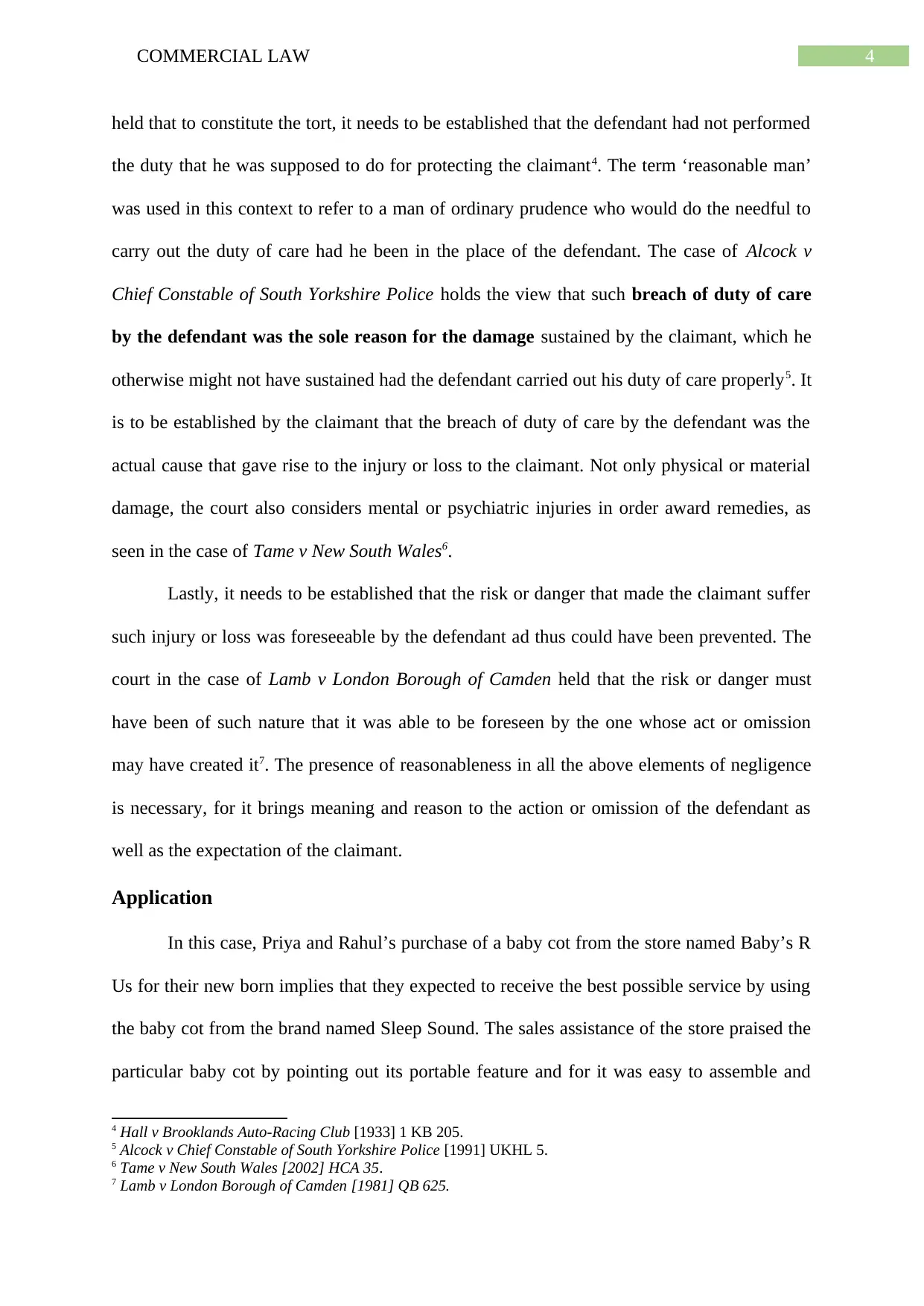
4COMMERCIAL LAW
held that to constitute the tort, it needs to be established that the defendant had not performed
the duty that he was supposed to do for protecting the claimant4. The term ‘reasonable man’
was used in this context to refer to a man of ordinary prudence who would do the needful to
carry out the duty of care had he been in the place of the defendant. The case of Alcock v
Chief Constable of South Yorkshire Police holds the view that such breach of duty of care
by the defendant was the sole reason for the damage sustained by the claimant, which he
otherwise might not have sustained had the defendant carried out his duty of care properly5. It
is to be established by the claimant that the breach of duty of care by the defendant was the
actual cause that gave rise to the injury or loss to the claimant. Not only physical or material
damage, the court also considers mental or psychiatric injuries in order award remedies, as
seen in the case of Tame v New South Wales6.
Lastly, it needs to be established that the risk or danger that made the claimant suffer
such injury or loss was foreseeable by the defendant ad thus could have been prevented. The
court in the case of Lamb v London Borough of Camden held that the risk or danger must
have been of such nature that it was able to be foreseen by the one whose act or omission
may have created it7. The presence of reasonableness in all the above elements of negligence
is necessary, for it brings meaning and reason to the action or omission of the defendant as
well as the expectation of the claimant.
Application
In this case, Priya and Rahul’s purchase of a baby cot from the store named Baby’s R
Us for their new born implies that they expected to receive the best possible service by using
the baby cot from the brand named Sleep Sound. The sales assistance of the store praised the
particular baby cot by pointing out its portable feature and for it was easy to assemble and
4 Hall v Brooklands Auto-Racing Club [1933] 1 KB 205.
5 Alcock v Chief Constable of South Yorkshire Police [1991] UKHL 5.
6 Tame v New South Wales [2002] HCA 35.
7 Lamb v London Borough of Camden [1981] QB 625.
held that to constitute the tort, it needs to be established that the defendant had not performed
the duty that he was supposed to do for protecting the claimant4. The term ‘reasonable man’
was used in this context to refer to a man of ordinary prudence who would do the needful to
carry out the duty of care had he been in the place of the defendant. The case of Alcock v
Chief Constable of South Yorkshire Police holds the view that such breach of duty of care
by the defendant was the sole reason for the damage sustained by the claimant, which he
otherwise might not have sustained had the defendant carried out his duty of care properly5. It
is to be established by the claimant that the breach of duty of care by the defendant was the
actual cause that gave rise to the injury or loss to the claimant. Not only physical or material
damage, the court also considers mental or psychiatric injuries in order award remedies, as
seen in the case of Tame v New South Wales6.
Lastly, it needs to be established that the risk or danger that made the claimant suffer
such injury or loss was foreseeable by the defendant ad thus could have been prevented. The
court in the case of Lamb v London Borough of Camden held that the risk or danger must
have been of such nature that it was able to be foreseen by the one whose act or omission
may have created it7. The presence of reasonableness in all the above elements of negligence
is necessary, for it brings meaning and reason to the action or omission of the defendant as
well as the expectation of the claimant.
Application
In this case, Priya and Rahul’s purchase of a baby cot from the store named Baby’s R
Us for their new born implies that they expected to receive the best possible service by using
the baby cot from the brand named Sleep Sound. The sales assistance of the store praised the
particular baby cot by pointing out its portable feature and for it was easy to assemble and
4 Hall v Brooklands Auto-Racing Club [1933] 1 KB 205.
5 Alcock v Chief Constable of South Yorkshire Police [1991] UKHL 5.
6 Tame v New South Wales [2002] HCA 35.
7 Lamb v London Borough of Camden [1981] QB 625.
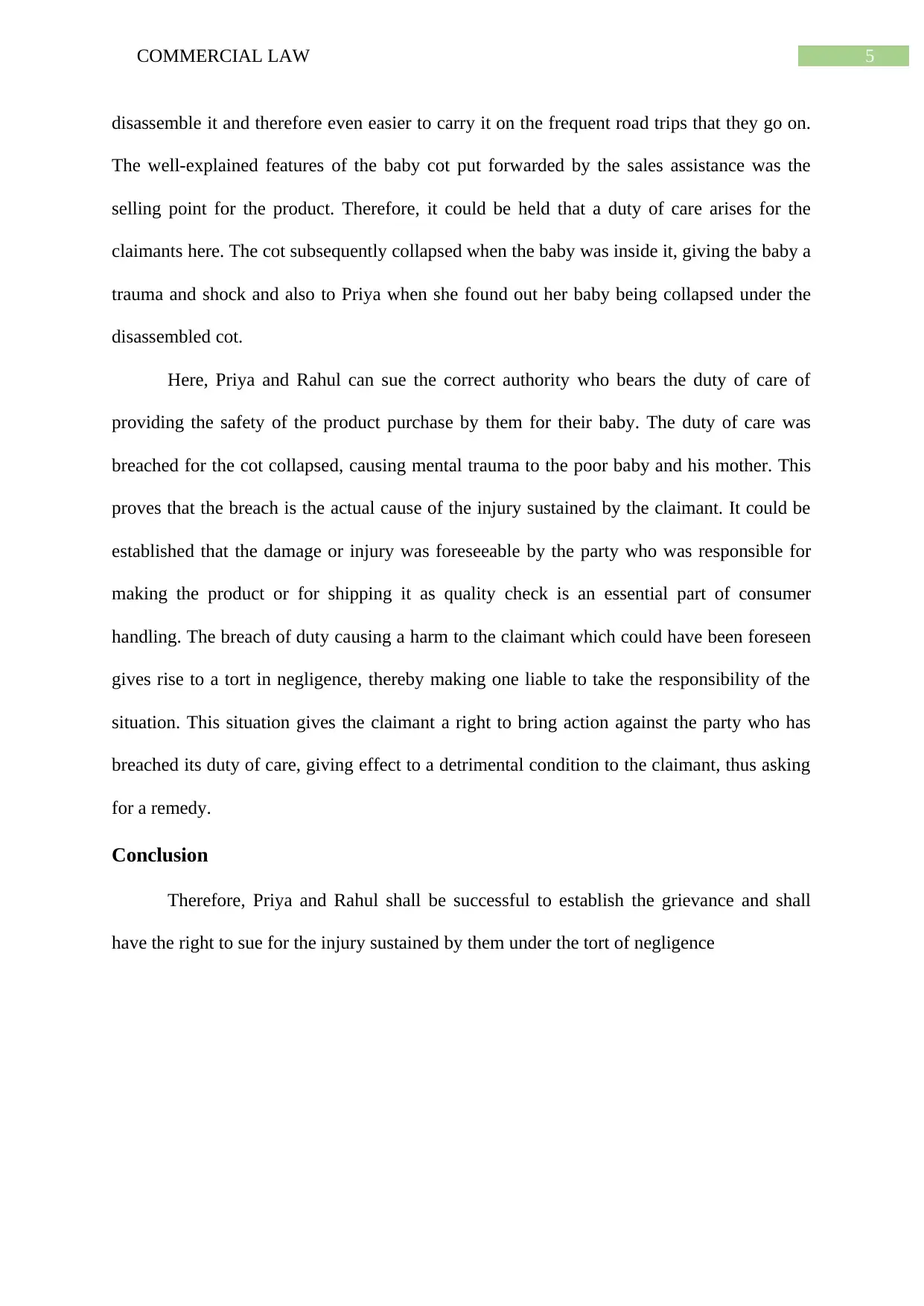
5COMMERCIAL LAW
disassemble it and therefore even easier to carry it on the frequent road trips that they go on.
The well-explained features of the baby cot put forwarded by the sales assistance was the
selling point for the product. Therefore, it could be held that a duty of care arises for the
claimants here. The cot subsequently collapsed when the baby was inside it, giving the baby a
trauma and shock and also to Priya when she found out her baby being collapsed under the
disassembled cot.
Here, Priya and Rahul can sue the correct authority who bears the duty of care of
providing the safety of the product purchase by them for their baby. The duty of care was
breached for the cot collapsed, causing mental trauma to the poor baby and his mother. This
proves that the breach is the actual cause of the injury sustained by the claimant. It could be
established that the damage or injury was foreseeable by the party who was responsible for
making the product or for shipping it as quality check is an essential part of consumer
handling. The breach of duty causing a harm to the claimant which could have been foreseen
gives rise to a tort in negligence, thereby making one liable to take the responsibility of the
situation. This situation gives the claimant a right to bring action against the party who has
breached its duty of care, giving effect to a detrimental condition to the claimant, thus asking
for a remedy.
Conclusion
Therefore, Priya and Rahul shall be successful to establish the grievance and shall
have the right to sue for the injury sustained by them under the tort of negligence
disassemble it and therefore even easier to carry it on the frequent road trips that they go on.
The well-explained features of the baby cot put forwarded by the sales assistance was the
selling point for the product. Therefore, it could be held that a duty of care arises for the
claimants here. The cot subsequently collapsed when the baby was inside it, giving the baby a
trauma and shock and also to Priya when she found out her baby being collapsed under the
disassembled cot.
Here, Priya and Rahul can sue the correct authority who bears the duty of care of
providing the safety of the product purchase by them for their baby. The duty of care was
breached for the cot collapsed, causing mental trauma to the poor baby and his mother. This
proves that the breach is the actual cause of the injury sustained by the claimant. It could be
established that the damage or injury was foreseeable by the party who was responsible for
making the product or for shipping it as quality check is an essential part of consumer
handling. The breach of duty causing a harm to the claimant which could have been foreseen
gives rise to a tort in negligence, thereby making one liable to take the responsibility of the
situation. This situation gives the claimant a right to bring action against the party who has
breached its duty of care, giving effect to a detrimental condition to the claimant, thus asking
for a remedy.
Conclusion
Therefore, Priya and Rahul shall be successful to establish the grievance and shall
have the right to sue for the injury sustained by them under the tort of negligence
⊘ This is a preview!⊘
Do you want full access?
Subscribe today to unlock all pages.

Trusted by 1+ million students worldwide
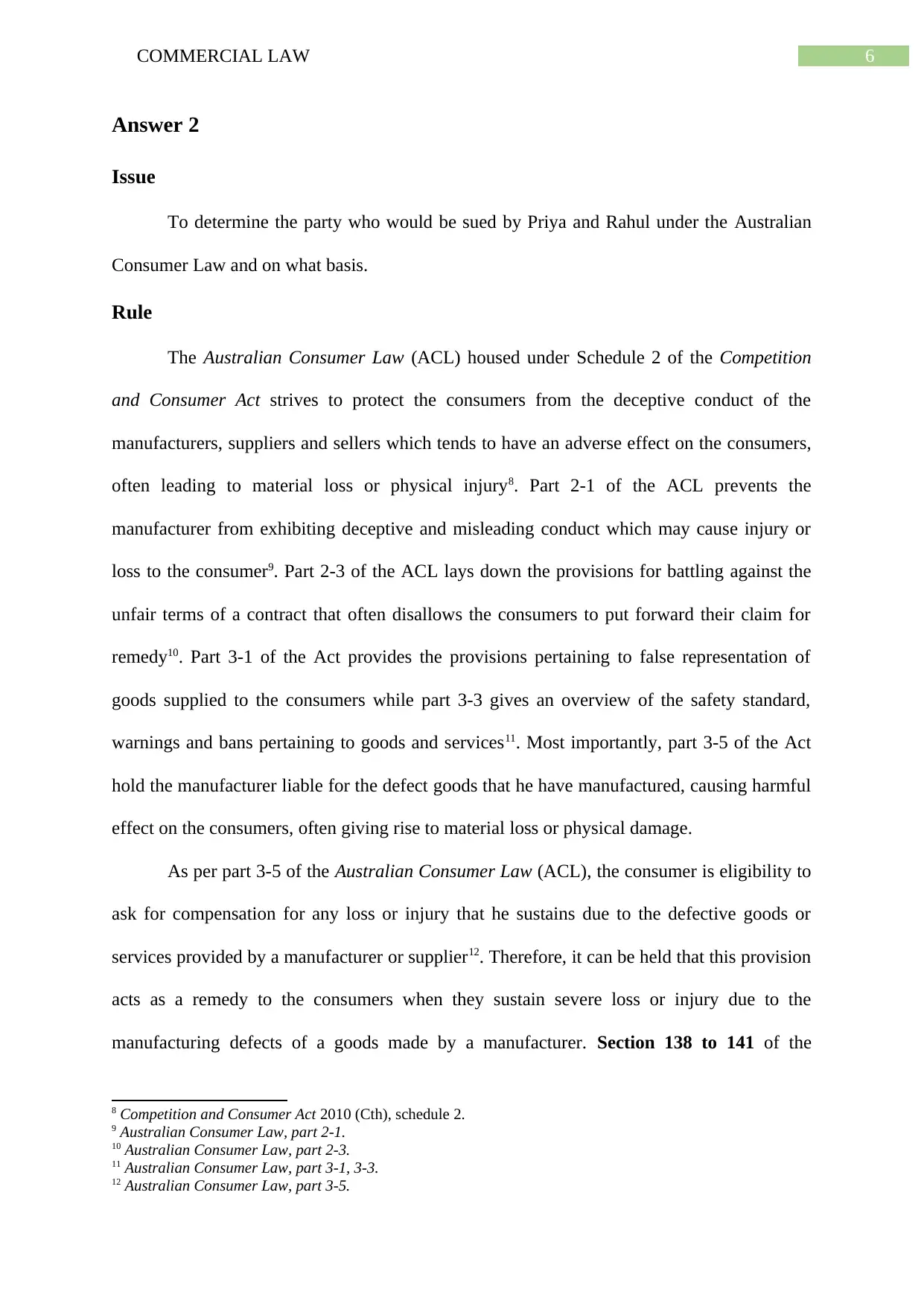
6COMMERCIAL LAW
Answer 2
Issue
To determine the party who would be sued by Priya and Rahul under the Australian
Consumer Law and on what basis.
Rule
The Australian Consumer Law (ACL) housed under Schedule 2 of the Competition
and Consumer Act strives to protect the consumers from the deceptive conduct of the
manufacturers, suppliers and sellers which tends to have an adverse effect on the consumers,
often leading to material loss or physical injury8. Part 2-1 of the ACL prevents the
manufacturer from exhibiting deceptive and misleading conduct which may cause injury or
loss to the consumer9. Part 2-3 of the ACL lays down the provisions for battling against the
unfair terms of a contract that often disallows the consumers to put forward their claim for
remedy10. Part 3-1 of the Act provides the provisions pertaining to false representation of
goods supplied to the consumers while part 3-3 gives an overview of the safety standard,
warnings and bans pertaining to goods and services11. Most importantly, part 3-5 of the Act
hold the manufacturer liable for the defect goods that he have manufactured, causing harmful
effect on the consumers, often giving rise to material loss or physical damage.
As per part 3-5 of the Australian Consumer Law (ACL), the consumer is eligibility to
ask for compensation for any loss or injury that he sustains due to the defective goods or
services provided by a manufacturer or supplier12. Therefore, it can be held that this provision
acts as a remedy to the consumers when they sustain severe loss or injury due to the
manufacturing defects of a goods made by a manufacturer. Section 138 to 141 of the
8 Competition and Consumer Act 2010 (Cth), schedule 2.
9 Australian Consumer Law, part 2-1.
10 Australian Consumer Law, part 2-3.
11 Australian Consumer Law, part 3-1, 3-3.
12 Australian Consumer Law, part 3-5.
Answer 2
Issue
To determine the party who would be sued by Priya and Rahul under the Australian
Consumer Law and on what basis.
Rule
The Australian Consumer Law (ACL) housed under Schedule 2 of the Competition
and Consumer Act strives to protect the consumers from the deceptive conduct of the
manufacturers, suppliers and sellers which tends to have an adverse effect on the consumers,
often leading to material loss or physical injury8. Part 2-1 of the ACL prevents the
manufacturer from exhibiting deceptive and misleading conduct which may cause injury or
loss to the consumer9. Part 2-3 of the ACL lays down the provisions for battling against the
unfair terms of a contract that often disallows the consumers to put forward their claim for
remedy10. Part 3-1 of the Act provides the provisions pertaining to false representation of
goods supplied to the consumers while part 3-3 gives an overview of the safety standard,
warnings and bans pertaining to goods and services11. Most importantly, part 3-5 of the Act
hold the manufacturer liable for the defect goods that he have manufactured, causing harmful
effect on the consumers, often giving rise to material loss or physical damage.
As per part 3-5 of the Australian Consumer Law (ACL), the consumer is eligibility to
ask for compensation for any loss or injury that he sustains due to the defective goods or
services provided by a manufacturer or supplier12. Therefore, it can be held that this provision
acts as a remedy to the consumers when they sustain severe loss or injury due to the
manufacturing defects of a goods made by a manufacturer. Section 138 to 141 of the
8 Competition and Consumer Act 2010 (Cth), schedule 2.
9 Australian Consumer Law, part 2-1.
10 Australian Consumer Law, part 2-3.
11 Australian Consumer Law, part 3-1, 3-3.
12 Australian Consumer Law, part 3-5.
Paraphrase This Document
Need a fresh take? Get an instant paraphrase of this document with our AI Paraphraser
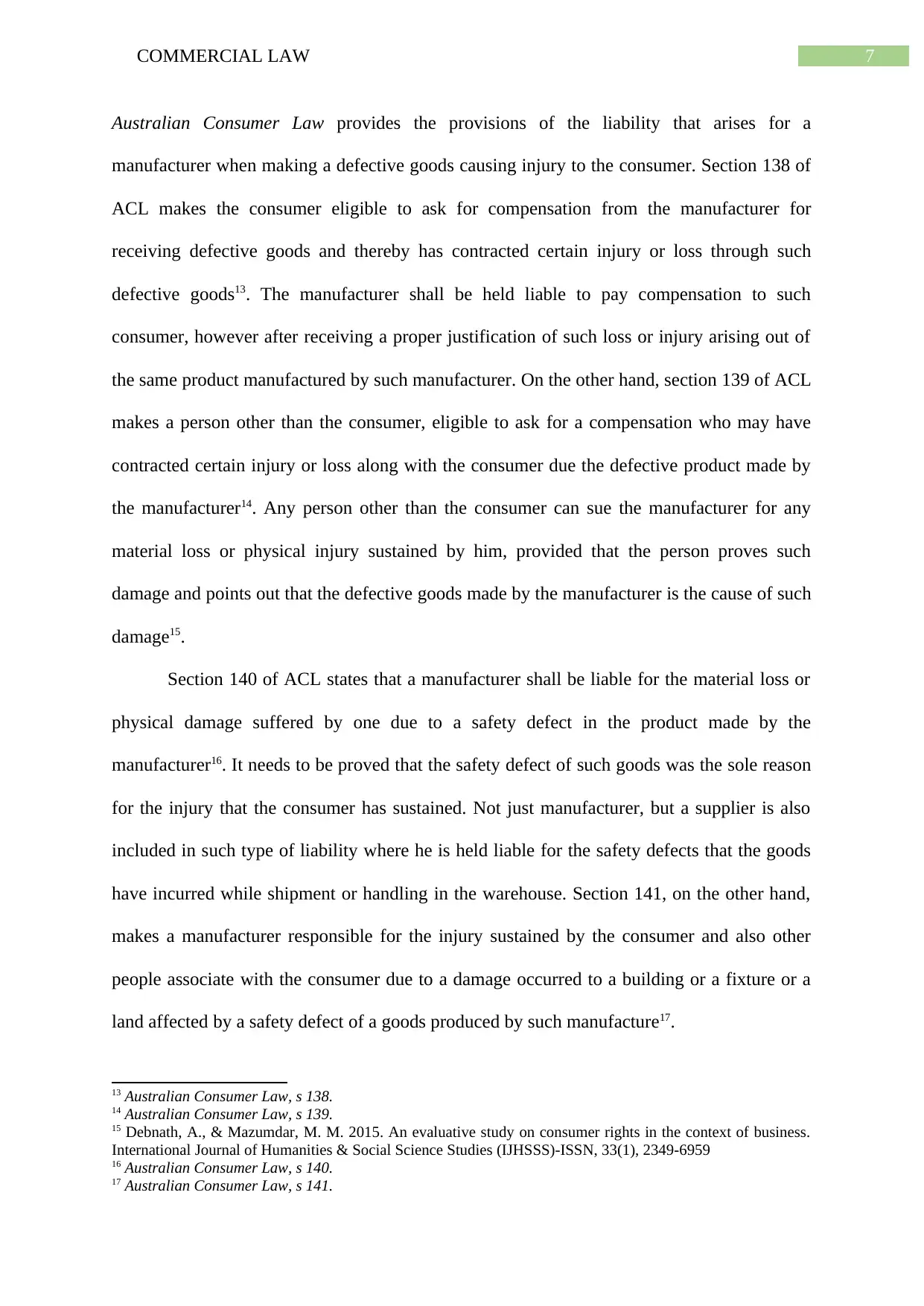
7COMMERCIAL LAW
Australian Consumer Law provides the provisions of the liability that arises for a
manufacturer when making a defective goods causing injury to the consumer. Section 138 of
ACL makes the consumer eligible to ask for compensation from the manufacturer for
receiving defective goods and thereby has contracted certain injury or loss through such
defective goods13. The manufacturer shall be held liable to pay compensation to such
consumer, however after receiving a proper justification of such loss or injury arising out of
the same product manufactured by such manufacturer. On the other hand, section 139 of ACL
makes a person other than the consumer, eligible to ask for a compensation who may have
contracted certain injury or loss along with the consumer due the defective product made by
the manufacturer14. Any person other than the consumer can sue the manufacturer for any
material loss or physical injury sustained by him, provided that the person proves such
damage and points out that the defective goods made by the manufacturer is the cause of such
damage15.
Section 140 of ACL states that a manufacturer shall be liable for the material loss or
physical damage suffered by one due to a safety defect in the product made by the
manufacturer16. It needs to be proved that the safety defect of such goods was the sole reason
for the injury that the consumer has sustained. Not just manufacturer, but a supplier is also
included in such type of liability where he is held liable for the safety defects that the goods
have incurred while shipment or handling in the warehouse. Section 141, on the other hand,
makes a manufacturer responsible for the injury sustained by the consumer and also other
people associate with the consumer due to a damage occurred to a building or a fixture or a
land affected by a safety defect of a goods produced by such manufacture17.
13 Australian Consumer Law, s 138.
14 Australian Consumer Law, s 139.
15 Debnath, A., & Mazumdar, M. M. 2015. An evaluative study on consumer rights in the context of business.
International Journal of Humanities & Social Science Studies (IJHSSS)-ISSN, 33(1), 2349-6959
16 Australian Consumer Law, s 140.
17 Australian Consumer Law, s 141.
Australian Consumer Law provides the provisions of the liability that arises for a
manufacturer when making a defective goods causing injury to the consumer. Section 138 of
ACL makes the consumer eligible to ask for compensation from the manufacturer for
receiving defective goods and thereby has contracted certain injury or loss through such
defective goods13. The manufacturer shall be held liable to pay compensation to such
consumer, however after receiving a proper justification of such loss or injury arising out of
the same product manufactured by such manufacturer. On the other hand, section 139 of ACL
makes a person other than the consumer, eligible to ask for a compensation who may have
contracted certain injury or loss along with the consumer due the defective product made by
the manufacturer14. Any person other than the consumer can sue the manufacturer for any
material loss or physical injury sustained by him, provided that the person proves such
damage and points out that the defective goods made by the manufacturer is the cause of such
damage15.
Section 140 of ACL states that a manufacturer shall be liable for the material loss or
physical damage suffered by one due to a safety defect in the product made by the
manufacturer16. It needs to be proved that the safety defect of such goods was the sole reason
for the injury that the consumer has sustained. Not just manufacturer, but a supplier is also
included in such type of liability where he is held liable for the safety defects that the goods
have incurred while shipment or handling in the warehouse. Section 141, on the other hand,
makes a manufacturer responsible for the injury sustained by the consumer and also other
people associate with the consumer due to a damage occurred to a building or a fixture or a
land affected by a safety defect of a goods produced by such manufacture17.
13 Australian Consumer Law, s 138.
14 Australian Consumer Law, s 139.
15 Debnath, A., & Mazumdar, M. M. 2015. An evaluative study on consumer rights in the context of business.
International Journal of Humanities & Social Science Studies (IJHSSS)-ISSN, 33(1), 2349-6959
16 Australian Consumer Law, s 140.
17 Australian Consumer Law, s 141.
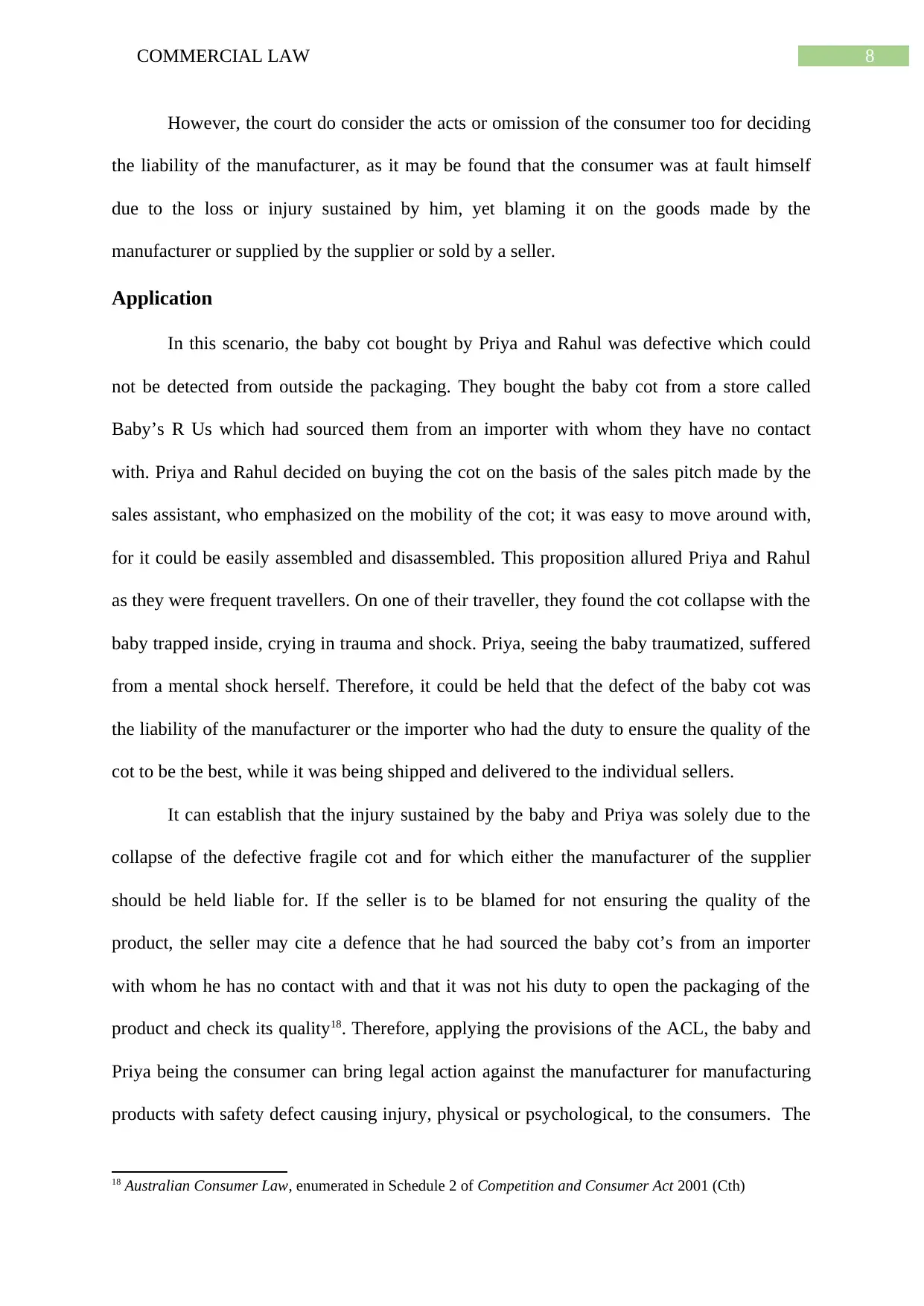
8COMMERCIAL LAW
However, the court do consider the acts or omission of the consumer too for deciding
the liability of the manufacturer, as it may be found that the consumer was at fault himself
due to the loss or injury sustained by him, yet blaming it on the goods made by the
manufacturer or supplied by the supplier or sold by a seller.
Application
In this scenario, the baby cot bought by Priya and Rahul was defective which could
not be detected from outside the packaging. They bought the baby cot from a store called
Baby’s R Us which had sourced them from an importer with whom they have no contact
with. Priya and Rahul decided on buying the cot on the basis of the sales pitch made by the
sales assistant, who emphasized on the mobility of the cot; it was easy to move around with,
for it could be easily assembled and disassembled. This proposition allured Priya and Rahul
as they were frequent travellers. On one of their traveller, they found the cot collapse with the
baby trapped inside, crying in trauma and shock. Priya, seeing the baby traumatized, suffered
from a mental shock herself. Therefore, it could be held that the defect of the baby cot was
the liability of the manufacturer or the importer who had the duty to ensure the quality of the
cot to be the best, while it was being shipped and delivered to the individual sellers.
It can establish that the injury sustained by the baby and Priya was solely due to the
collapse of the defective fragile cot and for which either the manufacturer of the supplier
should be held liable for. If the seller is to be blamed for not ensuring the quality of the
product, the seller may cite a defence that he had sourced the baby cot’s from an importer
with whom he has no contact with and that it was not his duty to open the packaging of the
product and check its quality18. Therefore, applying the provisions of the ACL, the baby and
Priya being the consumer can bring legal action against the manufacturer for manufacturing
products with safety defect causing injury, physical or psychological, to the consumers. The
18 Australian Consumer Law, enumerated in Schedule 2 of Competition and Consumer Act 2001 (Cth)
However, the court do consider the acts or omission of the consumer too for deciding
the liability of the manufacturer, as it may be found that the consumer was at fault himself
due to the loss or injury sustained by him, yet blaming it on the goods made by the
manufacturer or supplied by the supplier or sold by a seller.
Application
In this scenario, the baby cot bought by Priya and Rahul was defective which could
not be detected from outside the packaging. They bought the baby cot from a store called
Baby’s R Us which had sourced them from an importer with whom they have no contact
with. Priya and Rahul decided on buying the cot on the basis of the sales pitch made by the
sales assistant, who emphasized on the mobility of the cot; it was easy to move around with,
for it could be easily assembled and disassembled. This proposition allured Priya and Rahul
as they were frequent travellers. On one of their traveller, they found the cot collapse with the
baby trapped inside, crying in trauma and shock. Priya, seeing the baby traumatized, suffered
from a mental shock herself. Therefore, it could be held that the defect of the baby cot was
the liability of the manufacturer or the importer who had the duty to ensure the quality of the
cot to be the best, while it was being shipped and delivered to the individual sellers.
It can establish that the injury sustained by the baby and Priya was solely due to the
collapse of the defective fragile cot and for which either the manufacturer of the supplier
should be held liable for. If the seller is to be blamed for not ensuring the quality of the
product, the seller may cite a defence that he had sourced the baby cot’s from an importer
with whom he has no contact with and that it was not his duty to open the packaging of the
product and check its quality18. Therefore, applying the provisions of the ACL, the baby and
Priya being the consumer can bring legal action against the manufacturer for manufacturing
products with safety defect causing injury, physical or psychological, to the consumers. The
18 Australian Consumer Law, enumerated in Schedule 2 of Competition and Consumer Act 2001 (Cth)
⊘ This is a preview!⊘
Do you want full access?
Subscribe today to unlock all pages.

Trusted by 1+ million students worldwide
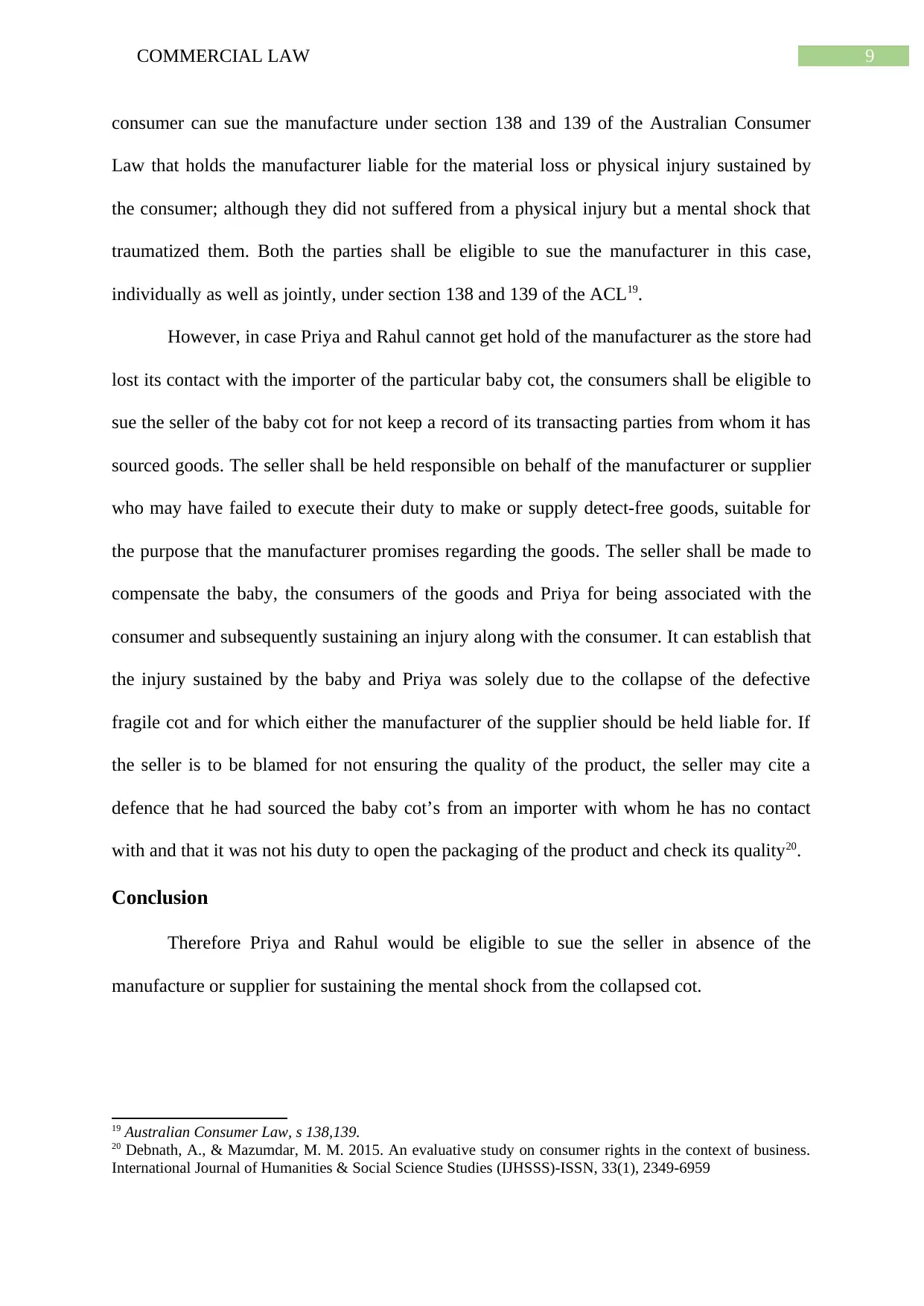
9COMMERCIAL LAW
consumer can sue the manufacture under section 138 and 139 of the Australian Consumer
Law that holds the manufacturer liable for the material loss or physical injury sustained by
the consumer; although they did not suffered from a physical injury but a mental shock that
traumatized them. Both the parties shall be eligible to sue the manufacturer in this case,
individually as well as jointly, under section 138 and 139 of the ACL19.
However, in case Priya and Rahul cannot get hold of the manufacturer as the store had
lost its contact with the importer of the particular baby cot, the consumers shall be eligible to
sue the seller of the baby cot for not keep a record of its transacting parties from whom it has
sourced goods. The seller shall be held responsible on behalf of the manufacturer or supplier
who may have failed to execute their duty to make or supply detect-free goods, suitable for
the purpose that the manufacturer promises regarding the goods. The seller shall be made to
compensate the baby, the consumers of the goods and Priya for being associated with the
consumer and subsequently sustaining an injury along with the consumer. It can establish that
the injury sustained by the baby and Priya was solely due to the collapse of the defective
fragile cot and for which either the manufacturer of the supplier should be held liable for. If
the seller is to be blamed for not ensuring the quality of the product, the seller may cite a
defence that he had sourced the baby cot’s from an importer with whom he has no contact
with and that it was not his duty to open the packaging of the product and check its quality20.
Conclusion
Therefore Priya and Rahul would be eligible to sue the seller in absence of the
manufacture or supplier for sustaining the mental shock from the collapsed cot.
19 Australian Consumer Law, s 138,139.
20 Debnath, A., & Mazumdar, M. M. 2015. An evaluative study on consumer rights in the context of business.
International Journal of Humanities & Social Science Studies (IJHSSS)-ISSN, 33(1), 2349-6959
consumer can sue the manufacture under section 138 and 139 of the Australian Consumer
Law that holds the manufacturer liable for the material loss or physical injury sustained by
the consumer; although they did not suffered from a physical injury but a mental shock that
traumatized them. Both the parties shall be eligible to sue the manufacturer in this case,
individually as well as jointly, under section 138 and 139 of the ACL19.
However, in case Priya and Rahul cannot get hold of the manufacturer as the store had
lost its contact with the importer of the particular baby cot, the consumers shall be eligible to
sue the seller of the baby cot for not keep a record of its transacting parties from whom it has
sourced goods. The seller shall be held responsible on behalf of the manufacturer or supplier
who may have failed to execute their duty to make or supply detect-free goods, suitable for
the purpose that the manufacturer promises regarding the goods. The seller shall be made to
compensate the baby, the consumers of the goods and Priya for being associated with the
consumer and subsequently sustaining an injury along with the consumer. It can establish that
the injury sustained by the baby and Priya was solely due to the collapse of the defective
fragile cot and for which either the manufacturer of the supplier should be held liable for. If
the seller is to be blamed for not ensuring the quality of the product, the seller may cite a
defence that he had sourced the baby cot’s from an importer with whom he has no contact
with and that it was not his duty to open the packaging of the product and check its quality20.
Conclusion
Therefore Priya and Rahul would be eligible to sue the seller in absence of the
manufacture or supplier for sustaining the mental shock from the collapsed cot.
19 Australian Consumer Law, s 138,139.
20 Debnath, A., & Mazumdar, M. M. 2015. An evaluative study on consumer rights in the context of business.
International Journal of Humanities & Social Science Studies (IJHSSS)-ISSN, 33(1), 2349-6959
Paraphrase This Document
Need a fresh take? Get an instant paraphrase of this document with our AI Paraphraser
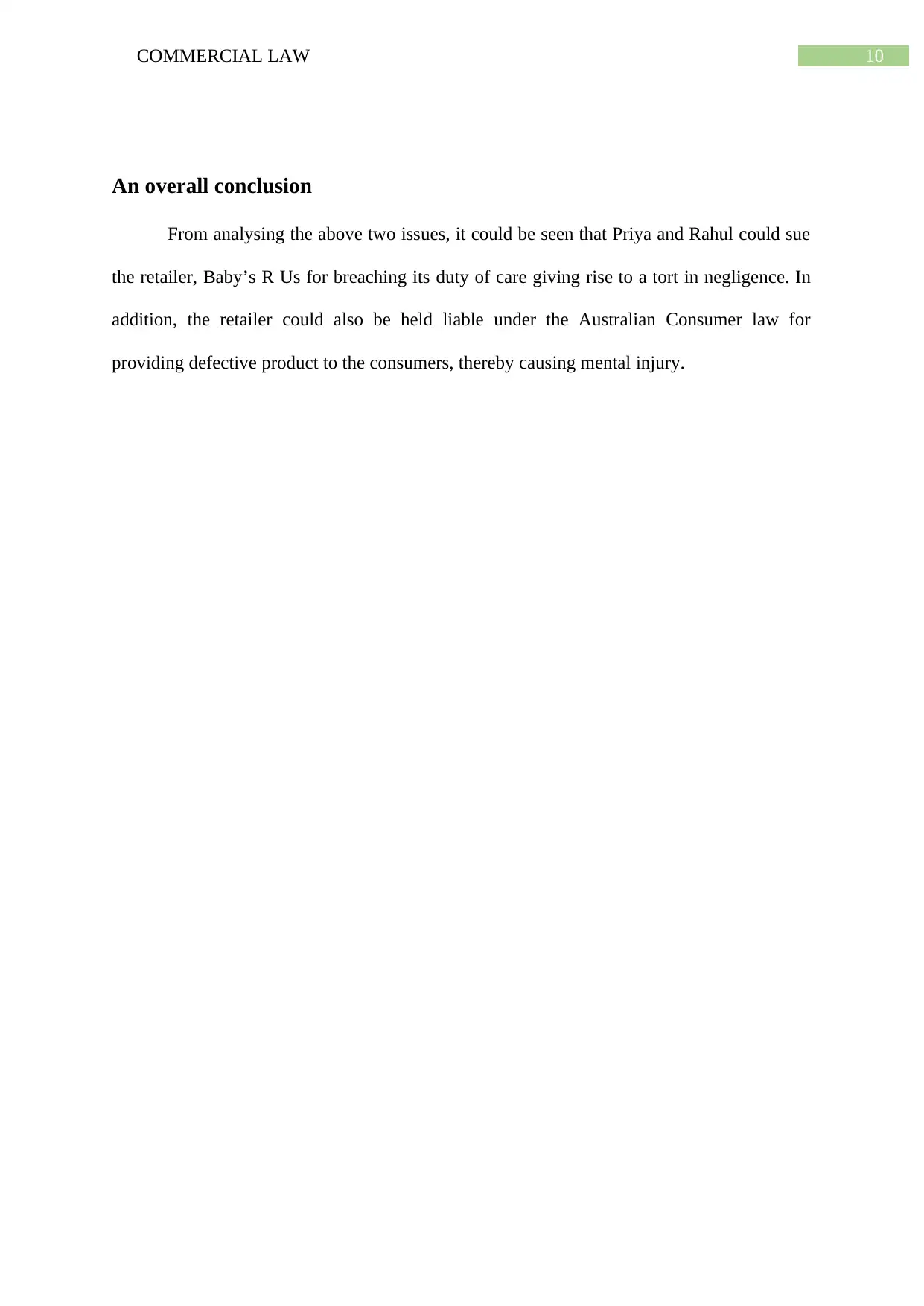
10COMMERCIAL LAW
An overall conclusion
From analysing the above two issues, it could be seen that Priya and Rahul could sue
the retailer, Baby’s R Us for breaching its duty of care giving rise to a tort in negligence. In
addition, the retailer could also be held liable under the Australian Consumer law for
providing defective product to the consumers, thereby causing mental injury.
An overall conclusion
From analysing the above two issues, it could be seen that Priya and Rahul could sue
the retailer, Baby’s R Us for breaching its duty of care giving rise to a tort in negligence. In
addition, the retailer could also be held liable under the Australian Consumer law for
providing defective product to the consumers, thereby causing mental injury.
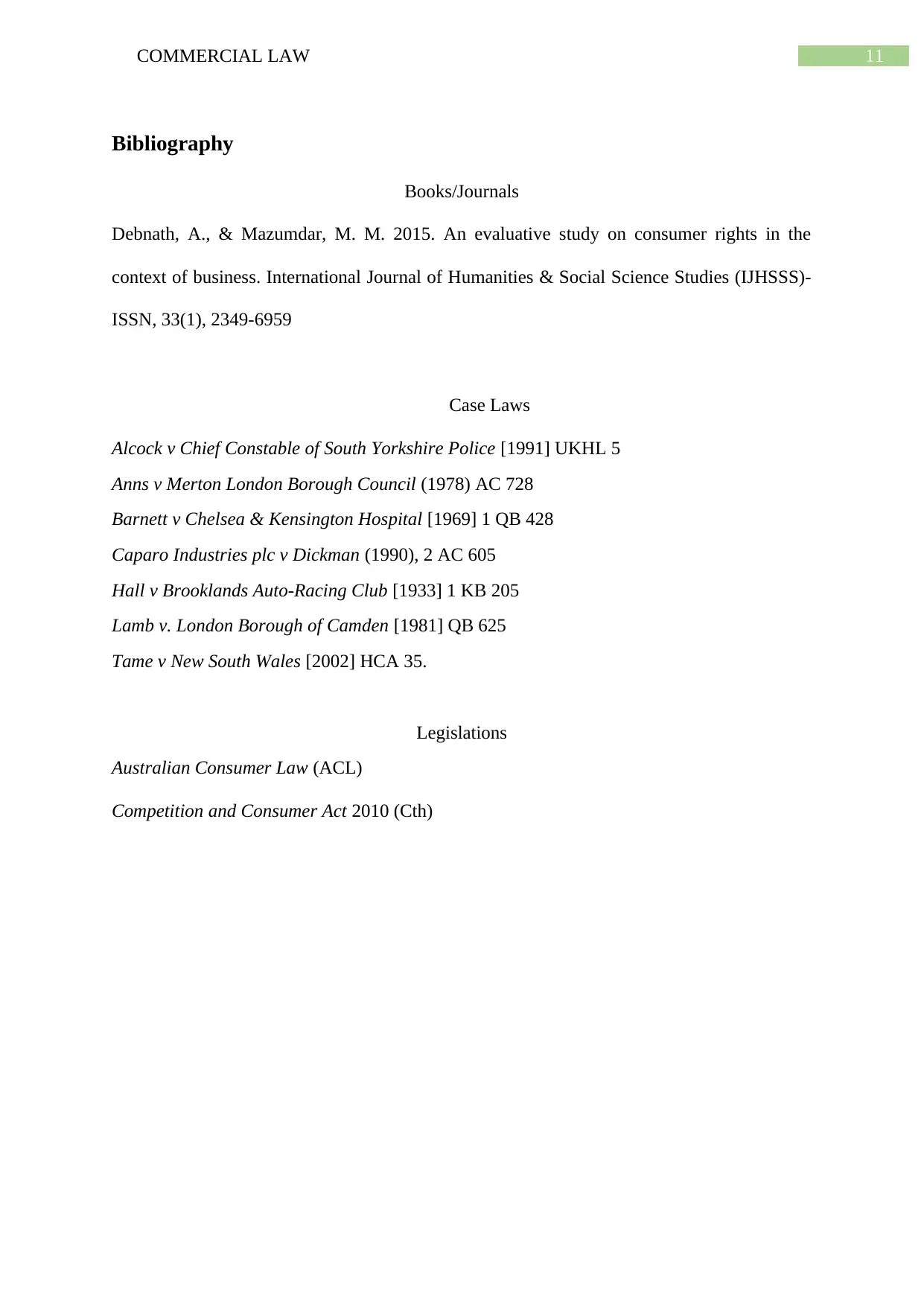
11COMMERCIAL LAW
Bibliography
Books/Journals
Debnath, A., & Mazumdar, M. M. 2015. An evaluative study on consumer rights in the
context of business. International Journal of Humanities & Social Science Studies (IJHSSS)-
ISSN, 33(1), 2349-6959
Case Laws
Alcock v Chief Constable of South Yorkshire Police [1991] UKHL 5
Anns v Merton London Borough Council (1978) AC 728
Barnett v Chelsea & Kensington Hospital [1969] 1 QB 428
Caparo Industries plc v Dickman (1990), 2 AC 605
Hall v Brooklands Auto-Racing Club [1933] 1 KB 205
Lamb v. London Borough of Camden [1981] QB 625
Tame v New South Wales [2002] HCA 35.
Legislations
Australian Consumer Law (ACL)
Competition and Consumer Act 2010 (Cth)
Bibliography
Books/Journals
Debnath, A., & Mazumdar, M. M. 2015. An evaluative study on consumer rights in the
context of business. International Journal of Humanities & Social Science Studies (IJHSSS)-
ISSN, 33(1), 2349-6959
Case Laws
Alcock v Chief Constable of South Yorkshire Police [1991] UKHL 5
Anns v Merton London Borough Council (1978) AC 728
Barnett v Chelsea & Kensington Hospital [1969] 1 QB 428
Caparo Industries plc v Dickman (1990), 2 AC 605
Hall v Brooklands Auto-Racing Club [1933] 1 KB 205
Lamb v. London Borough of Camden [1981] QB 625
Tame v New South Wales [2002] HCA 35.
Legislations
Australian Consumer Law (ACL)
Competition and Consumer Act 2010 (Cth)
⊘ This is a preview!⊘
Do you want full access?
Subscribe today to unlock all pages.

Trusted by 1+ million students worldwide
1 out of 12
Related Documents
Your All-in-One AI-Powered Toolkit for Academic Success.
+13062052269
info@desklib.com
Available 24*7 on WhatsApp / Email
![[object Object]](/_next/static/media/star-bottom.7253800d.svg)
Unlock your academic potential
Copyright © 2020–2025 A2Z Services. All Rights Reserved. Developed and managed by ZUCOL.





